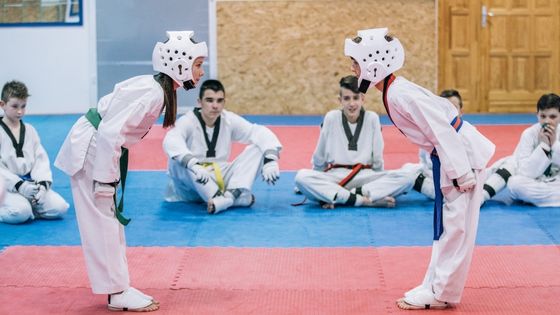Karate, judo, and Taekwondo are the most popular combat sports in the world. However, while Judo and Taekwondo were already part of the Olympic games, Karate got inducted into the tournament only recently in 2020 in Tokyo.
Those unfamiliar with their individual characteristics often mix them up with one another. But each sport, i-e, karate, judo, and taekwondo, has unique attributes, origin, history, and techniques. Even the attires are different from each other. For example, Karate uniforms are completely different from Judo uniforms, while taekwondo practitioners wear similar but somewhat different taekwondo uniforms. This article highlights the unique characteristics and details that make each of them different from the others.


History
All these three forms of martial arts were created with different purposes and techniques. However, the history of all three of them goes back to the 1800s. Read the details:
- Judo: Judo was developed in 1882 by KanJigoro as an unarmed combat technique. In an effort to fortify his weak frame, a young Kano Jigoro Shihan took up Jujutsu. However, he also took a keen interest in other fighting systems, eventually becoming an expert in the most in-depth teachings. By combining what he saw as their strengths with his own thoughts and inspirations, he created a new system of physical technique. Furthermore, he updated the ancient Jujutsu theory of “defeating strength with flexibility” into the new principle, i-e, “maximum efficient use of physical and mental energy.” As a result, a new technical and theoretical framework was developed that, in Kano’s opinion, better serves the needs of contemporary society.
- Taekwondo: Taekwondo has a strong emphasis on kicks. In the 1940s and 50s, various Korean martial artists created taekwondo by combining the indigenous Korean fighting techniques of taekkyeon, gwonbeop, and subak with influences from foreign martial arts, including karate and Chinese martial arts. Some say More than a thousand years ago, on the Korean peninsula, taekwondo first appeared. The martial technique was surreptitiously passed down by masters during the first half of the 20th century despite being outlawed by the Japanese occupier government. After the Second World War, the first president of South Korea saw a demonstration that distinguished it from karate. In the 1950s, gyms started popping up all across the nation.
- Karate: A martial technique called karate was created in the Ryukyu Kingdom. Under the influence of Chinese martial arts, especially Fujian White Crane, it evolved from the native Ryukyuan martial arts known as “te,” which means “hand.”
Origin:
- Judo: Japan
- Taekwondo: Korea
- Karate: Japan
Position in Olympics
- Judo: Judo got accepted as a sport in Olympics in 1964.
- Taekwondo: It officially became an Olympic game in 2000.
- Karate: Karate was included in Olympic sports recently in 2021.
Practitioners:
- Judo: Judo practitioners Are called “judokas.”
- Taekwondo: Those who practice taekwondo are called “Taekwondoin.”
- Karate: Karate Practitioners are called karatekas
Uniforms:
- Judo: Judo uniforms are called “judogis.” They are white or blue in color.
- Taekwondo: Taekwondo competitors dress in white doboks. Along with gloves, a mouthguard, and even detecting socks for the electronic scoring system, they must also wear guards on their forearms, shins, groynes, and chest.
- Karate: Karate uniforms are called gis. They are white in color, and karatekas wear them with blue or red belts and matching gloves.
Techniques
- Judo uses grappling techniques to pin the opponent to the ground by grasping onto control spots on the opponent’s body that come with a slight balance. Judo is effective in close-quarters situations and completes the throw quickly.
- Taekwondo uses a variety of kicks, punches, spinning kicks, front kicks, roundhouses, and jumping kicks.
- Karate: Karate is primarily a striking art, and because there are no circular motions, jumps, or fancy over-the-board moves, one may deal with it by using as little strength as possible. In order to perform a swift, precise, and potent strike, karate practitioners must make contact with their muscles during the attack.
Winning points
- Judo: Judo fights run four minutes, and the object is to use throws, groundwork and strikes to subdue the opposition. Kicking and punching are prohibited. When an opponent is swiftly and expertly tossed on their back with strength, the opponent receives the Ippon (full point), and the match is declared over. Otherwise, a judoka earns a waza-ari (half point) if they can hold their opponent motionless for 10 seconds. An ippon (full point) is awarded after a 20-second immobility, and the winner is declared automatically. One ippon is equal to two waza-ari. Judokas are given waza-ari for throws less strong than an ippon, such as ones that roll their opponent onto their back or land on their shoulders.
- Taekwondo: Taekwondo competitions are held on octagonal mats. The winner is determined by who accumulates the most points overall after three two-minute rounds of competition. A “golden point” round is added in case of a tie. The number of points awarded can range from one (for a punch to the chest protector) to five, depending on the sort of strike and where it falls (for a turning kick to the head).
- Karate: There are two forms of karate, Kata and Kumite. Men’s matches in Kumite karate last three minutes, while women’s matches last two minutes. Depending on the technique’s application, one, two, or three points may be given for each kick, strike, or punch delivered to an opponent. The objective is to score the most points, and if one fighter acquires an eight-point lead, the fight may be declared over early.
There are 98 recognized techniques in kata karate, and contestants are expected to display a variety of moves that are evaluated for timing, strength, power, balance, and speed.
Classification by weight
To guarantee that competitors are evenly matched, weight divisions are used in judo, Kumite karate, and taekwondo.
- Judo: Each gender has seven different weight categories in judo, ranging from 48 kg to +78 kg for women and 60 kg to +100 kg for men.
- Taekwondo: There are four Olympic weight classes in taekwondo, one for each gender, ranging from 49 kg to 67 kg for women and 58 kg to 80 kg for men.
- Karate: In Kumite karate, there are three weight classes per gender, while kata is classified by gender only.
Organizations
- Judo: The International Judo Federation oversees judo globally and hosts professional competitions on the IJF world circuit.
- Taekwondo: The Korea Taekwondo Association (KTA), founded in 1959 by members from the country’s founding nine kwans, or martial arts schools, is the sport’s oldest regulating body. The International Taekwondo Federation (ITF), established by General Choi Hong Hi in 1966, and the World Taekwondo Federation (WTF), established by the KTA in 1973, are currently the two primary international organizations for Taekwondo. Since 1992, the Olympic sport of gyeorugi, a form of full-contact sparring, has been held. The World Taekwondo Federation is the organization responsible for taekwondo in the Olympics.
- Karate: The International Olympic Committee (IOC) recognizes the World Karate Federation (WKF) as being in charge of karate competitions in the Olympic Games. It is the largest sport karate organization. All styles are governed by standard guidelines created by the WKF. In cooperation with their respective National Olympic Committees, the national WKF organizations.
Conclusion
We discussed the fundamental differences between Judo, Taekwondo, and Karate. The takeaway of the articles reflects that the three forms of martial arts are designed with unique, striking techniques. Punching and hand-based attacks have been the main emphasis of karate. Taekwondo, on the other hand, emphasizes complex kicking patterns. While judo focuses on grappling and ground combat methods.
Heavy protection gear is worn by practitioners as they study self-defense or martial arts that rely on hitting. For rigorous training drills, StarPro Combat provides top-notch protective gear and attire, such as Judo uniforms (judogi), Karate uniforms (Gi), and taekwondo uniforms (doboks).
























